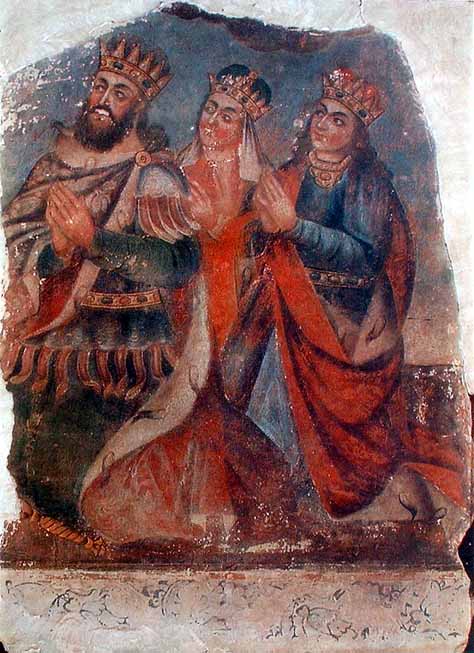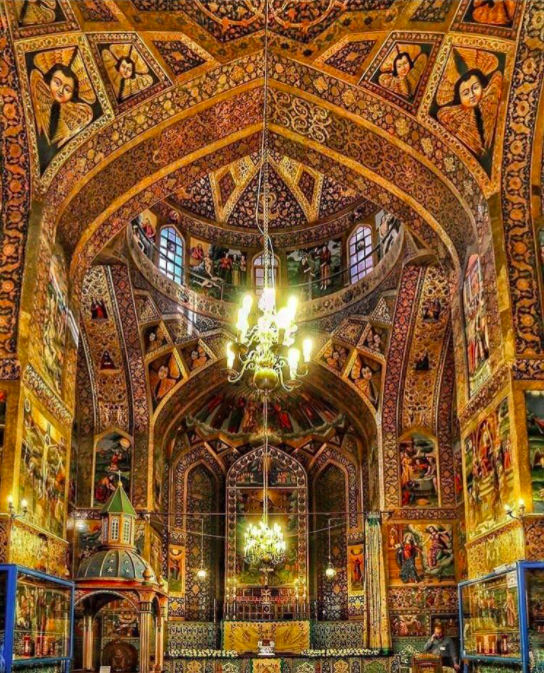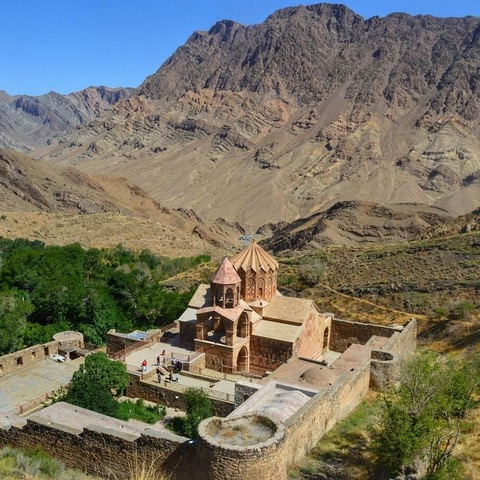It is not possible to separate the history of Armenia from the greater Iranian cultural and political landscapes.
The name Armenia first appeared in Darius the Great Behistun Inscription (517B.C), Old Persia, Armina. “Xenophon a Greek general serving in some of the Persian expeditions, describes many aspects of Armenian village life and hospitality in around 401 BC. He relates that the people spoke a language that to his ear sounded like the language of the Persians.”
François Lenormant a French archaeologist believed the Armenian alphabets were derived from Avestan letters more than the Greek alphabets. The Armenian language was a spoken language without any written alphabets. So the Bible and the liturgy of the Armenian language were written in Greek, Syriac, or Pahlavi. It was Catalicos Sahak who commissioned Mesrob to create the Armenian alphabets. Mesrop Mashtots was a linguist and fluent in Persian and Greek and was in the service of Khosrov IV king of Armenia.
Territorial claims over Armenia had always triggered wars between Rome and Persia. Armenia after becoming the first nation to adopt Christianity as its official religion began to shift slowly toward Rome. The Roman Empire itself was split between Byzantine with its capital in Constantinople, and Rome. Armenia’s version of Christianity was more aligned with the Byzantine brand of Christianity which is also referred to as Eastern Orthodox.
The majority of Armenians and Iranians for centuries also shared the same religion.
Armenia was ruled by the Arsacid dynasty since around 50 AD. The arsacid dynasty was in fact a branch of the Parthian dynasty one of the seven families of the House of Suren governing Armenia till about 428 AD. The dynastic family remained in power even after the fall of the Parthian Empire. It was only natural that their long reign in Armenia made them gradually more Armenians, although ethnically they were Iranians. The majority of Armenians and Iranians for centuries also shared the same religion. According to Mary Boyce, the prominent scholar of Zoroastrianism, ‘In the late Parthian period, Armenia was predominantly a Zoroastrian-adhering land and it was only after their Christianisation that Zoroastrianism and other practices declined.’
Persia during the Parthian period, unlike its successor the Sassanids was not as religiously defined, perhaps because it came to power out of the Greek cultural realm that dominated the region since Alexandra’s conquest of Persia. Seleucid Empire ruled over a large stretch of land, encompassing many peoples and religions. The Parthian empire also witnessed the genesis of Christianity and their missionary activities around the Middle East. The three Magi in the gospel of Matthew travelled from the Parthian territory to bring gifts for the new Messiah. Another reference to Parthia in the Bible is on the day of Pentecost in the book of Acts II where Parthian traders were present and heard the message of the gospel in their own language.
It’s very hard to argue that Armenia adopted Christianity because politically was in their best interest. Not initially. Rome was still persecuting the Christians when Tiridates III became the king of Armenia and declared Christianity as the state religion in 301 AD. It wasn’t until 313 AD that the persecution of Christians stopped through the Edict of Millan issued by Emperor Constantine, and all their confiscated properties returned to them. It is quite possible that Armenia’s daring conversation to Christianity en masse inspired Constantine, realising that it was possible to shed the old religion without risking to lose out in the political sphere. Tiridates had spent many years in Rome and very likely he had met Constantine when he was still a general or even took part in a few of his military battles. Armenia was also very much under the protection of Rome and Constantine had firsthand information about the progress of Armenia’s new religion. Armenia was an important province, strategically.
Rome and Persia never hesitated in fighting over its control. The significance of Tiridates’ decision to change the national religion of his kingdom would have reverberated throughout not just Persia but more so in Rome because Rome still was hostile to the converts of the new religion. Rome was, however, very different from Armenia. It took some years after the Edict of Millan for Christianity to become the state religion in the Empire. However, in the meantime, Constantine became the patron of the Christian faith and financially supported the church. It is easy to overlook Tiridates’ achievement. It was a brave and risky move that paid off and it paved the way for others to follow. Although it has been suggested that Tiridates’ decree in 301 was in defiance of Persia but the evidence, on the contrary, suggests that it was more in defiance of Rome. Only by the coming of Constantine the Great to power in 306 and the decree of Milan 5 years later the pressure on Christians was eased. Tiridates would have in fact placed himself at odds with the Romans. Or perhaps the decree was genuine and organically followed his conversion and was not politically motivated and never intended to be in defiance of Rome or Persia!

Who was Tiridates III (or Tirdad . تیرداد ) and how did he become a Christian? The fallout between Arsacid dynasty and the upcoming and very powerful Iranian dynasty, the Sassanids, began as early as Ardeshir I (r.211/2–224) its founder. Ardeshir had already killed Artabanus V of Parthia, the last king of the Parthians, and liquidate his empire. Artabanus was also Tiridates II’s (Armenian King) paternal uncle. According to Mary Boyce Arsacid dynasty was the last stronghold of another powerful Parthian family that the Sassanids couldn’t afford to ignore. Inevitably war between the two dynasties broke out. After 10 years of fighting Ardeshir’s victory was not decisive enough and he withdrew. Tiridates II was determined to hang on to his power with the backing of the entire Armenian nobbles and their army. It wasn’t till the coming of the newly crowned prince, Shapur, Ardeshir’s son that the Sassanids established themselves as a new superpower. Shapur entered the world stage by killing a Roman Emperor (Gordian III) in a battle and taking another Roman Emperor (Valerian) as his prisoner. However, still, the problem of control over Armenia remained but instead of going to war with Armenia, he decided to assassinate their king, Khosrov II. This time an assassin from a noble Parthain family by the name of Anak is sent to Armenia to accomplish this hideous act. Anak was promised the governorship of Armenia if he succeeded in his mission. Although Anak did assassinate Khosrov II he and his entire family were put to death by the Armenians as revenge. Only one of his sons was rescued by his carers. He was taken to Keyseri in Cappadocia and given to the Christians in a monastery to be raised and educated. We don’t know what his Iranian name was but his new Christian name was Gregory and later he became Saint Gregory the Illuminator.
Armenia had to tread carefully after the assassination of their king. The successor to the Arsacid throne was Tiridates III, the surviving son of Khosrov, nothing could stop Shapur from invading Armenia, which he later did. It was decided in order to protect him from the harm he should be sent to Rome. In Rome, Tiridates was safe until he could one day triumphantly return to Armenia as their king. When Narseh became King of Persia it seemed at first that Armenia could have been completely subdued by him who had given himself the title, ’King of Armenia’.

Narseh, wanting to continue his legendary father’s (Shapur) expansionist policy triggered fresh wars with Rome. But his early great military victories only followed by more spectacular defeats. He made a grave mistake by fighting the Roman General, Galerious in Armenia. Perhaps his choosing of Armenia as the battleground was also to determine the political fate of Armenia once for all. But he was walking into a trap. Armenians quickly made contact with Galerious who had once been soundly defeated by Narseh to coordinate their assault. Galerious agreed with the Armenian proposed strategy. Narseh’s superior calvary was more than useless in the rough Armenian terrains. Their combined forces took Narseh by surprise and crushed his army in the battle of Satala and his entire family and entourage were captured by the Romans. Narseh narrowly escaped. The new peace treaty that he had no choice but to sign ensured Armenia was free from Persia’s interference. Tiridates III finally returned to Armenian with the backing of Rome. He married an Iranian Princess, Ashkhen from the tribe of Alans who became the Queen of Armenia. His marriage to Ashken is a strong indication that the Arsacid kings were bilingual, they spoke their own Iranian/Parthian dialect and Armenian.
For a while, Tiridates with the backing of Rome ruled over his country without fear of invasion from Persia. However, he soon found out that the Roman Emperor, Diocletian had incorporated some of the provinces of Armenia into the Roman territory. Tiridates was devastated. Years of living in exile, fearing annihilation by the Persians, and now betrayed by his main supporter took a heavy toll on his mental health and he began to behave irrationally and out of character. In the meanwhile, Gregory was making small gains in the land of Armenia by converting the Armenians to Christianity despite the persecution faced by the adherents of the new religion. However, when his real identity was revealed he was arrested and imprisoned.

As Tiridates’s health was fast deteriorating and he was losing his grip on reality a vision was revealed to his sister, Khosrovidukht that only Gregory could cure the king of his wretched mental state. Gregory still alive after more than 10 years of imprisonment was called out of his dark dungeon to lay his healing hand on Tiridates. Gregory miraculously restored Tiridates to his normal mental state and he began to recover. Tiridates shortly afterward was baptised by St Gregory along with his entire family and the army. Tiridates also allowed Gregory to evangelise freely to the people of Armenia and then he declared Christianity as the state religion in 301 A.D. “Tiridates announced Gregory to be the first Catholicos of the Armenian Orthodox Church and sent him to Caesarea to be consecrated.”
The succession of the Catholicos in the Armenian Orthodox Church was in the Parthian dynastic fashion. It was only assigned to members of the Parthian family. After St Gregory, his two sons, St. Aristaces I and Vrtanes succeed their father as Catholicos and were commissioned to strengthen the Armenian Church and evangelise the people in the Caucasus and Anatolia.
***
Cover photo: The Holy Savior Cathedral (Armenian: Սուրբ Ամենափրկիչ Վանք – Surb Amenaprkich Vank; Persian: کلیسای آمناپرکیچ – Kelisā ye Āmenāperkič), also known the Church of the Saintly Sisters, is a cathedral located in the New Julfa district of Isfahan, Iran. It is commonly referred to as the Vank (Վանք; وانک), which means “monastery” or “convent” in the Armenian language.






